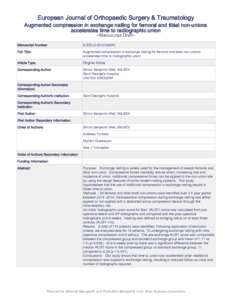Weil, S; Fontalis, A; Guessoum, M; Trompeter, A
(2021)
Augmented compression in exchange nailing for femoral and tibial non-unions accelerates time to radiographic union.
Eur J Orthop Surg Traumatol, 31 (5).
pp. 931-936.
ISSN 1633-8065
https://doi.org/10.1007/s00590-021-02900-w
SGUL Authors: Trompeter, Alex Joel
![[img]](https://openaccess.sgul.ac.uk/113073/6.hassmallThumbnailVersion/Augmented_compression_in_exchange_nailing.pdf)  Preview |
|
PDF
Accepted Version
Available under License ["licenses_description_publisher" not defined].
Download (1MB)
| Preview
|
Abstract
PURPOSE: Exchange nailing is widely used for the management of aseptic femoral and tibial non-union. Compressive forces markedly reduce strain, increasing rate and incidence of union. Additional compressive forces can be applied to the non-union site by using the design features of some modern nailing systems. This study hypothesises that the use of additional compression in exchange nailing results in faster time to union. METHODS: All femoral and tibial shaft non-unions were identified over a 4-year period between 2014-2018. Intraoperative compression during exchange nailing was either applied or not applied with a dedicated active compression device through the intramedullary nail. An initial 'radiographic union score for tibia' (RUST) score was calculated from preoperative lateral and AP radiographs and compared with the postoperative radiographs at 6-8 weeks. Healing was defined as bridging callus on at least three cortices (RUST > 10). RESULTS: A total of 119 patients were identified. Following application of exclusion criteria, we analysed data for 19 patients, 10 undergoing exchange nailing with intraoperative compression and 9 without. The pre-exchange RUST score was comparable between the compressed group and standard exchange group with mean of 7.11 versus 7.5 (p = 0.636). At 6-8 weeks post-op, there was a significant difference between the median RUST score in the compressed group vs standard exchange group, 11 compared to 8.39 (p = 0.001). CONCLUSIONS: Our study shows that time to union was accelerated when additional compression was applied to exchange nailing, resulting in reduced follow-up visits and number of radiographs required.
Statistics
Item downloaded times since 24 Mar 2021.
Actions (login required)
 |
Edit Item |



